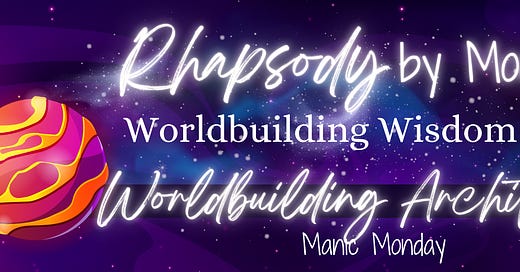The Power of Place: Six Ways to Showcase Your World with Architecture
A new week brings a new theme: Architecture. Join Haly for an exploration of six key principles about your fictional world that you can spotlight through architecture!
Manic Monday: Worldbuilding Architecture
Every fictional world is a quest of personal discovery for the creator. Just like your world will never be exactly the same as mine, neither will our journeys bear more than a passing resemblance. For instance, we each have different safe zones, different preferences or areas where we feel especially confident when worldbuilding. (For instance, my friend Mochi loves making new species, but doesn’t feel so strong about cultures.)
One of the areas I’ve been overlooking in both my own worldbuilding is architecture. This tells me…that it’s an area that some of you might be struggling with as well!
All of our characters have places, places they came from, places they’re going to, places they’ll stop or see along the way. And most of those places…are buildings. Home, the inn, the temple, the blacksmith, the local manor, the royal residence; each of these is a building, a constructed thing with a purpose, made from materials, according to local custom, to service people.
Architecture can show much about a place and the people who live there, including the local values, resources, terrain, physics, social hierarchy, and technology level.
Six Things to Show Through Architecture
Values — A culture that values privacy, will value doors, curtains, and walls. A culture that is more open will utilize archways and windows. Fences speak of a culture that is divided, while a lack of fences would suggest a more communal living. An entire village might share a bake house, well, or dining place. Their homes would, naturally, lack these communal spaces.
Resources — Buildings are usually constructed from local resources. A mountain castle would likely be made of local stone, while an inn along the forest road would be constructed almost entirely of wood. In the clay-rich southwestern United States, Pueblo homes were constructed with adobe, while the native tribes of the plains used leather hides to weatherproof their homes.
Terrain — The local geography can have a huge effect on your architecture. In the flat land of Indiana, our shopping malls are only a single story, and sprawl for city blocks in all directions. This would not work for a city nestled in a canyon or narrow valley. A hostile alien environment might require a facility to be entirely contained. And interstellar space is a terrain all its own!
Physics — Going hand-in-hand with terrain, physics is the most instrumental part of architecture. This is especially important in sci-fi worldbuilding where many stories are in space, or on alien planets with completely different ratios of atmosphere and gravity. But more than that, physics includes the constraints of space. For instance, if you are building inside of a cave, then you are physically bound by the limits of that finite space.
Social Hierarchy — Through human history, there has been a difference between the palaces of the powerful rulers, and the hovels of the humble workers. The architecture of your world can illustrate the differences in social status with clarity, even when such things aren’t acknowledged among the people themselves. Think of imported materials, decorative features, and enhanced security.
Technology Level — The Egyptians, the Mayans, the Greeks all constructed amazing buildings with basic manpower and simple tools. But colonize Mars they did not. Nor, at this time, have we. The level of technology available to your people will determine much about the buildings they can erect. Again, this is especially critical when dealing with sci-fi, and also with historical fiction.
I hope this look at how you can spotlight critical worldbuilding elements — social values, local resources, terrain, physics, social hierarchy, and technology level — through architecture has inspired you to think about the buildings where your characters live, work, stay, and play. Tomorrow, we’ll have a look at how the environment plays a part in the architecture of a world!
In the meantime, tell me in the comments about an important building in your world, and what its architecture says about its place and people!






This is great! I don't have many buildings in my thing yet, so I haven't thought about it that much, but this is really helpful.
Since my world has a lot of dragons, I'd think that houses would have an open-concept floor plan and large yards with no fences (as they would probably be destroyed easily haha (or maybe a line of trees as a form of fence / defining a property line)).
I have thought about having large courtyard-like things in cities (Almost like a park, I guess, or a dragon parking lot LOL) to let your dragon hang out while you hit up some shops or something that can't accommodate large dragons.
I realise that this isn't too specific and that's because it describes the architecture of the sector as a whole. I'll delve into specifics with its regions.
One of them, Binawalk is the hub for innovation, invention and collaboration. I like to think that because cooperation is the name of the game, homes wouldn't be separated by barriers and would boast wide lawns to enable multiple people, usually aspiring inventors and entrepreneurs, to have large meetings with each other.
I also like to think that the buildings the residents live in are shaped a certain way to accommodate their business venture and living space. Imagine two rectangles sitting beside each other—the left, smaller one is the place of the residents' business venture or where they showcase their creations. The right, larger rectangle is their living area. It is usually big enough to fit a maximum of five people.